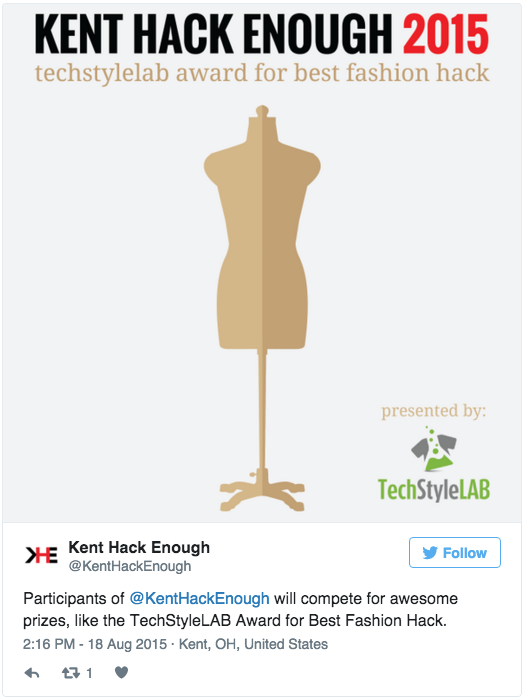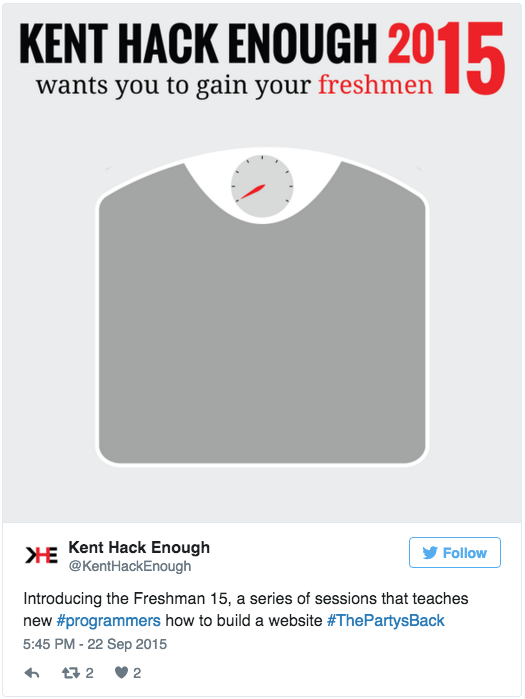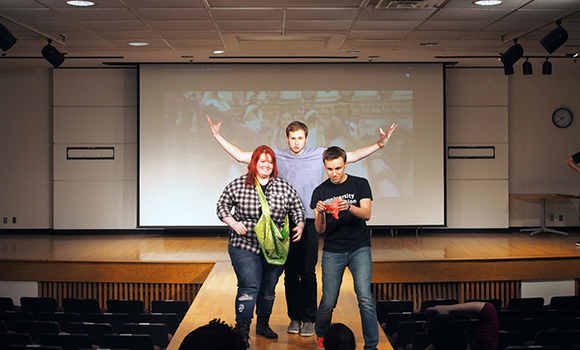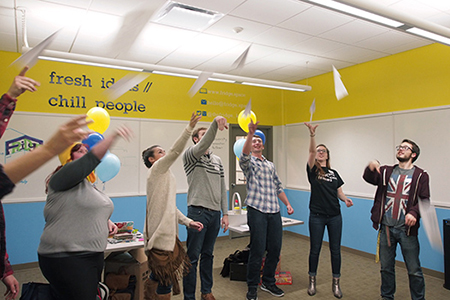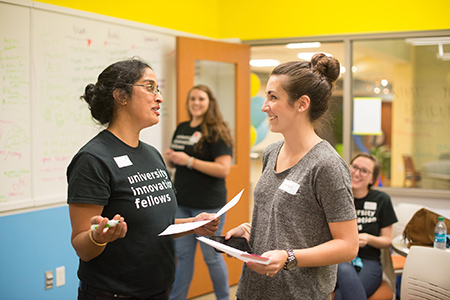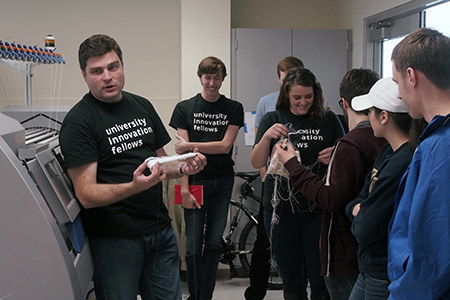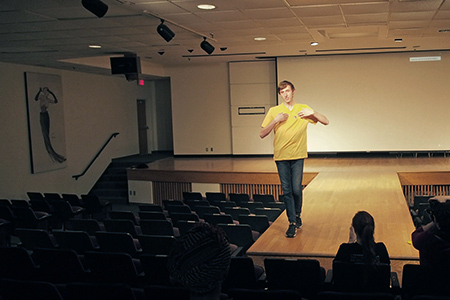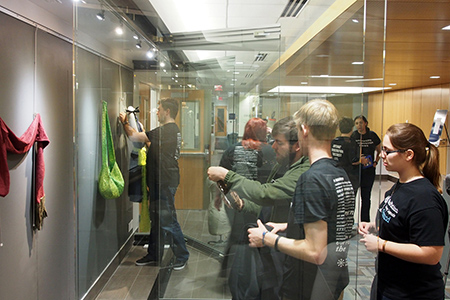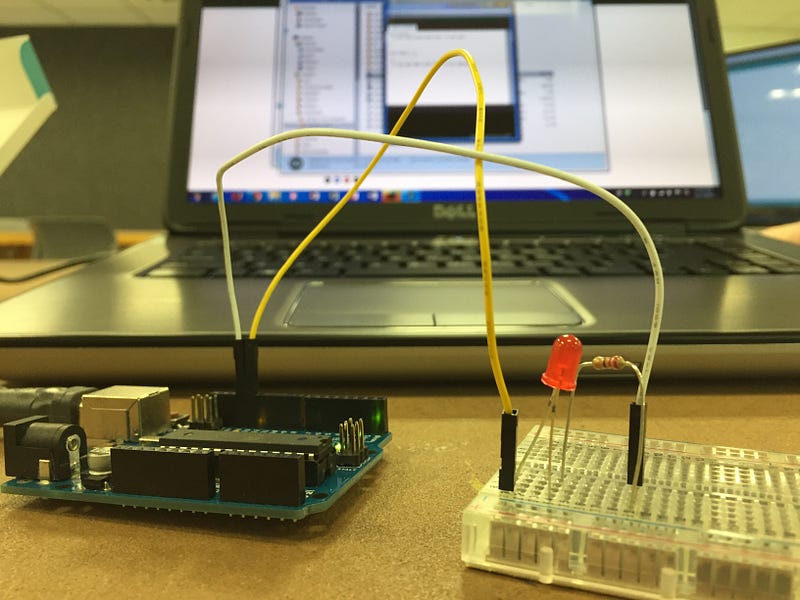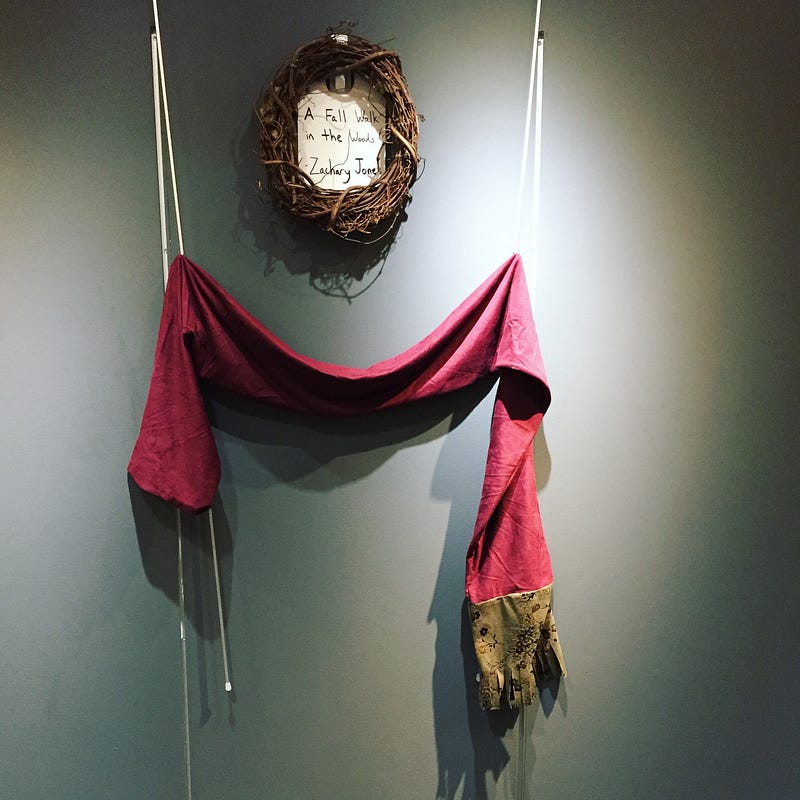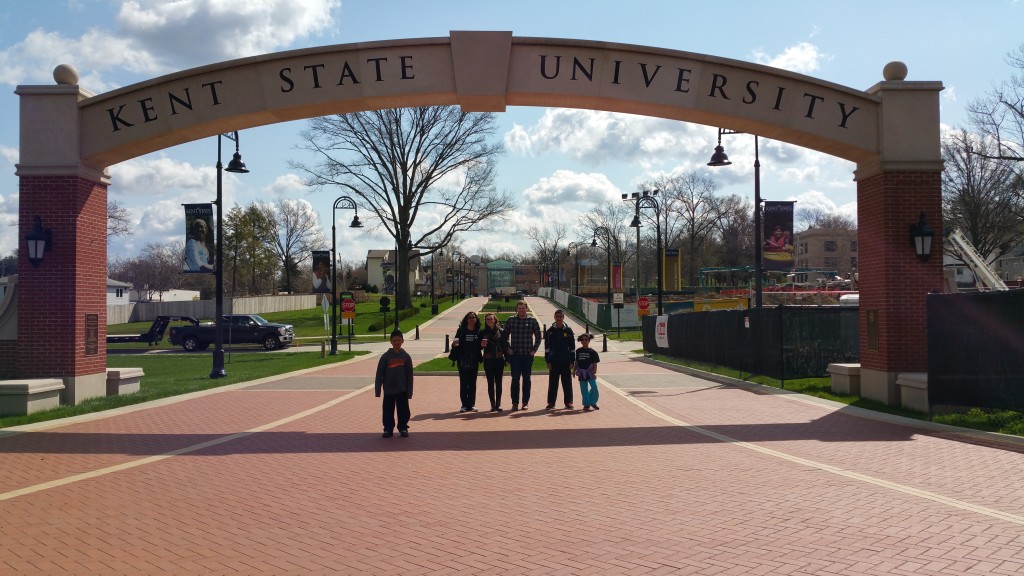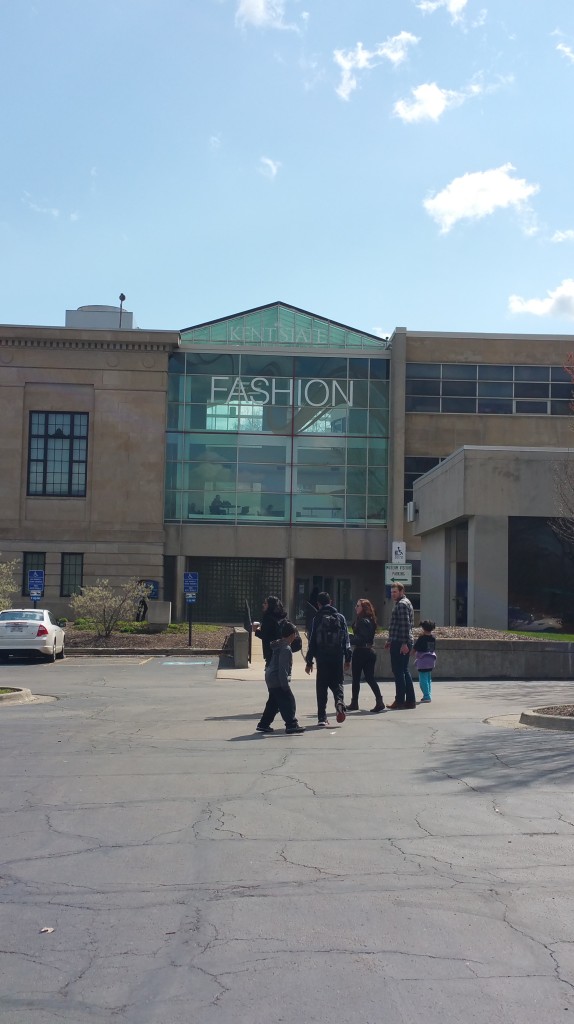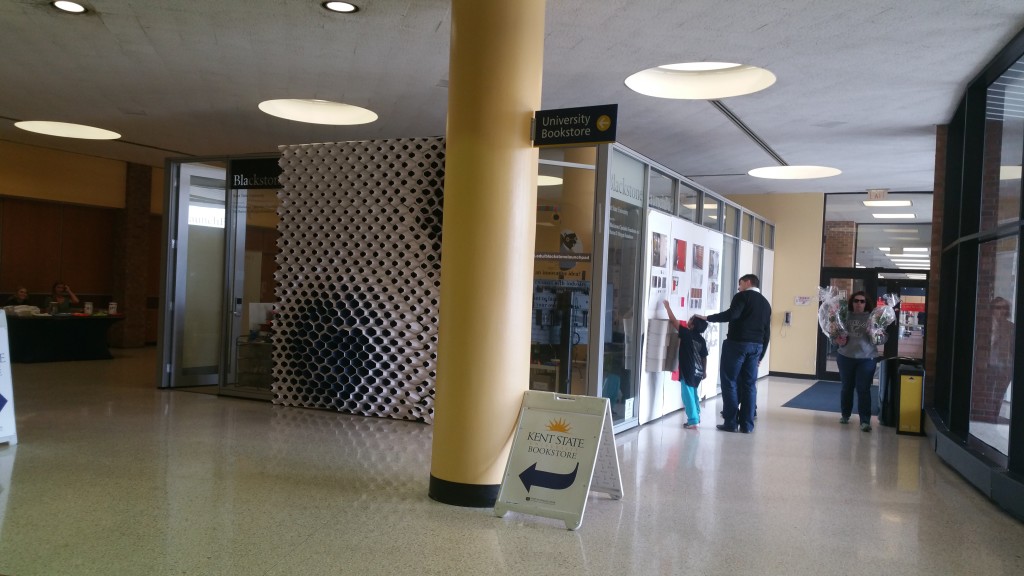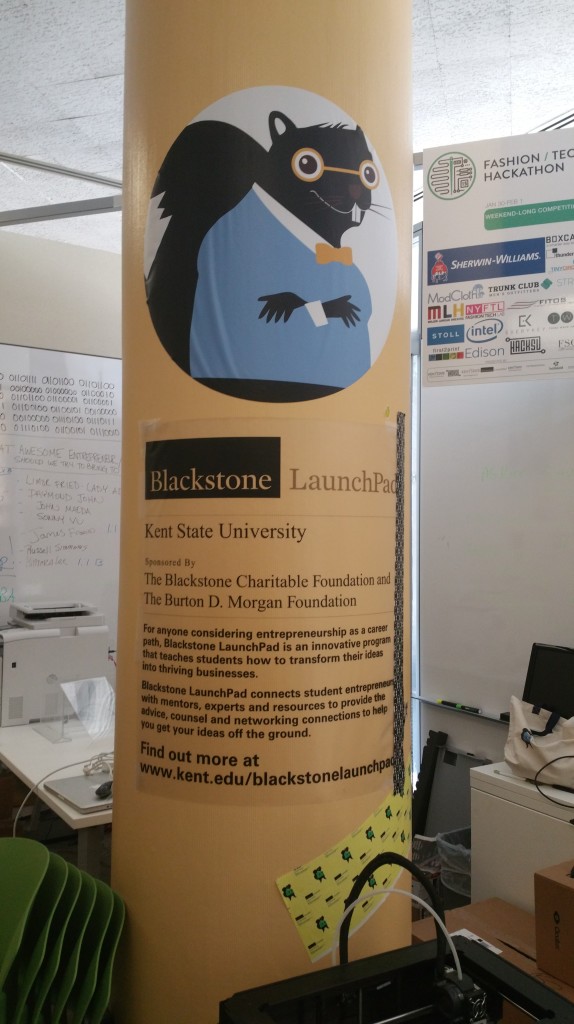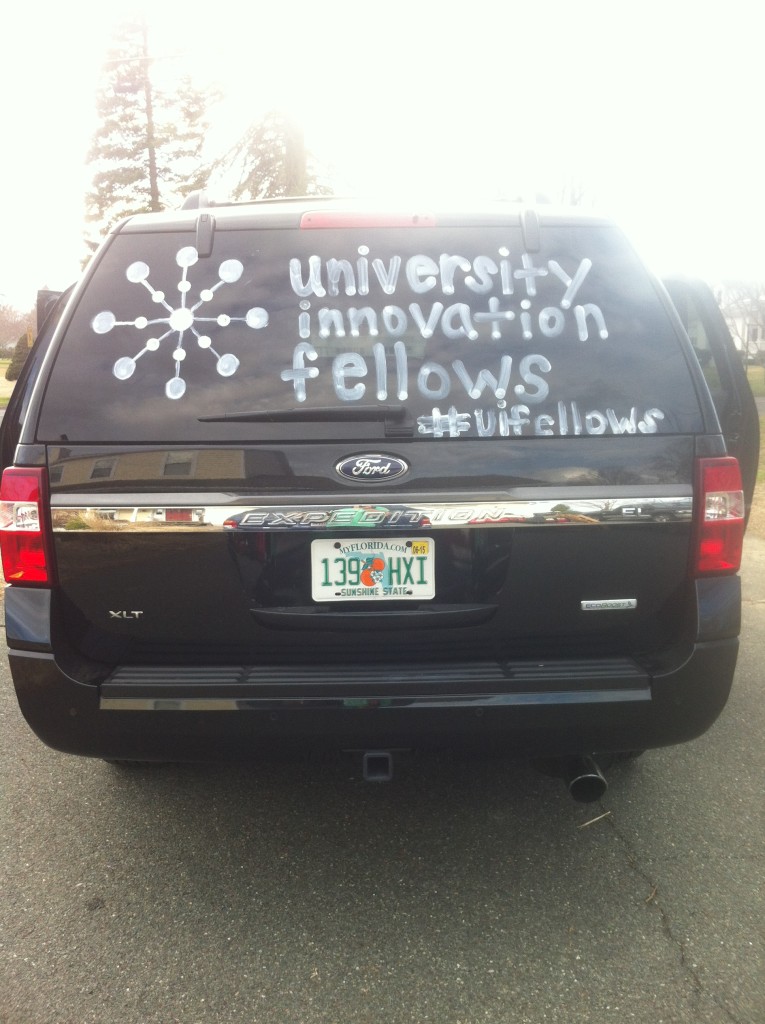Kent Hack Enough 2015
Originally published in the Diary of HackSU on medium.com
by Paul Dilyard and Robin Bonatesta, Kent State University
Introduction
Kent Hack Enough started in 2012, with a group of about 20 friends in the Math and Computer Science building at Kent State University. Since then, we have grown to over 250 attendees in 2015 (we have as many volunteers now as there were hackers at the first event!). Robin Bonatesta and I (Paul Dilyard) took over leadership of our CS student org (HacKSU), and therefore the organization of KHE, in Spring 2014. We have been able to take the foundations of awesomeness that the original leaders left us, and expand them to a level we are really proud of.
This post is a recap of our experiences organizing what turned out to be a really successful event: Kent Hack Enough 2015. We hope this article is useful for future KHE organizers, anyone looking to organize a small-to-medium sized event, and the hackathon community as a whole. We’ll take you through all the different components that go into a hackathon, including volunteer teams, finances, sponsorship, marketing, statistics from the event, and more.
Volunteers
Something we wanted to improve from last year was the level of involvement from volunteers. Last year, pretty much all the planning was done by Robin and I, and we had far too many sleepless nights. We did have an excellent experience with our volunteers day-of, however.
Robin and I run HacKSU, a student organization at Kent State that is responsible for Kent Hack Enough. We took over as co-leaders in Fall 2014, and have been working on growing the org ever since. The member-base consists of about 60 people at our weekly meetings (where we teach people to code from the beginning to the advanced), 20 of which are die-hard, committed people we can count on. Naturally, this is where we pulled our volunteers from. We ended up with 23 total volunteers; some were more involved during the planning stage, and some were more involved day-of (we definitely needed both).
We initially created a team structure, each team with a team leader. The team leaders would have to go through Robin and I for budgetary decisions, but other than that, teams had a lot of freedom. Here’s a list of all the teams we set up:
- Marketing (social media, plastering posters, recruiting other schools, etc.)
- Travel (answered travel reimbursement requests, organized busses)
- Food (planned meals, snacks, etc.)
- Development (mobile apps)
- The Frat (big ideas team)
Some of these teams’ responsibilities are more obvious than others.
Development team
I was responsible for the main website, as well as the staff backend, while the other members of the development team worked on apps for iOS, Android, and Windows Phone. No hackathon really needs apps, but I think it’s key to let people get involved where they want to be involved. We had volunteers that were interested in creating apps, and it was a learning process for everyone. And learning is what hackathons are about.
The Frat
We got the idea for this team from the awesome organizers of HackIllinois 2014 and their Moonshots team. They were responsible for making our attendees have fun, which we think is a really important aspect to KHE. We gave them the freedom to do anything they could think of that would add to the overall experience of the event. This team thought of and implemented ideas such as the FooBar (a non-alcoholic open bar serving mixed drinks based on Red Bull), and the Freshman 15 (a series of 15 workshops for beginner hackers).
In the end, The Frat moved towards a more project-based structure, with some members focusing on the FooBar and other members focusing on the Freshman 15.
Team-wise, anything financial (sponsorship, budget, etc.) was left solely to the lead organizers: Robin and I.
Finance, budget, and sponsors
First, a little background about our bank account. We use a business checking account with Huntington National Bank for our student organization (HacKSU). We use this account for all expenses related to HacKSU, including Kent Hack Enough. As an official student org, we have the option of using a university supplied and managed bank account. The previous leaders and founders of HacKSU had already decided not to go down this route, and for good reason: university accounts tend not to give you enough control (or haste). We already know how hard it can be to deal with administration, and luckily, we don’t have to when it comes to money. I know many hackathons don’t have this option, but we’ve been blessed with our own bank account.
We do, however, have to go through the university for one of our sponsors, the Knight Foundation. They are only able to get money to us by first issuing a check to the KSU Foundation, who is then able to release the funds to HacKSU through reimbursement. However, reimbursement isn’t good enough for us. We need that sponsorship money before the event, or it won’t be able to be utilized(it’s $5,000). Last year, KHE was in October 2014, but we didn’t get this money until January 2015. Through a series of blunt phone calls and emails to a contact in the KSU Foundation, I was able to convince administration that this was unacceptable and unnecessary, and we were able to submit our budget instead of our receipts. The check was in my hands about a week-and-a-half before the event. This might give you an idea of why we like to manage our own funds.
The numbers
As we grow, so does our budget. This year, we budgeted for about $24,000, with the sponsorship goal of $30,000 in mind. We always try to leave about $3,000 extra in the bank every year to fund our student organization. We also tend to be extremely conservative when making the budget, so in both 2014 and 2015 we’ve come in well under budget. Here’s a breakdown of what we budgeted for and what we actually spent:
(Format = Category: $Budgeted, $Spent)
Food
Meals: $7300, $7223.85
Snacks: $700, $500.02
Drinks: $1000, $632.47
Foo Bar: $1100, $674.10
Supplies
Utensils: $300, $389.40
Misc: $200, $69.96
Transportation
Reimbursement: $1000, ~$800
Buses: $3000, $1200
Swag
Shirts: $4000, $4128
Wristbands: $300, $154.70
Custom playing cards: $200, $160.39
Stickers: $200, $187.00
Custom branded cups: $0, $600
Cinch bags: $0, $539.00
Volunteer shirts: $500, $738.61
Prizes
First: $2000, $2000
Second: $1000, $1000
Third: $500, $500
This is not the complete budget, nor is it fully up to date (I’m writing this only one day after the event, so all day-of expenses have not yet been accounted for). Inevitably, every single purchase made for the hackathon has been logged for our records. I’ll try to come back and update this post with the final numbers, but these should give you the general idea of what we spent.
Achieving our sponsorship goals
We were really fortunate to raise our goal of $30,000 this year. This may not seem like a huge goal for a hackathon, but being in Northeast Ohio, there are not a lot of tech companies or companies in general that really get it. A lot of the companies in our area are more traditional and still would rather pay to attend the career fair than a hackathon. To combat this, we built asponsorship packet that we hoped would encourage some of our longer term supports to step up one level of sponsorship. This didn’t work quite as well as we hoped; most of our returning sponsors stuck to the same level as they have had in the past. This year we also built in a Start Up tier, as Cleveland and Akron have a growing start up community, where young, small companies could still afford to be involved for cheaper. While this worked in a few cases, some of our older supporters decided to choose this tier, event though they were not start ups.
Fortunately, this year we were able to gain 9 new companies (about half of our sponsors). Many of these came to us directly because they had heard about previous events or alumni had begun working there. A few other relationships had been formed through our student organization. Companies contact us all year long about recruiting our members for internships and full time jobs. We began agreeing to spread the word once, but if they wanted to recruit from HacKSU again, they would have to support Kent Hack Enough. This was really successful. As mentioned above, we also want to really improve the diversity of majors at the event, so Robin joined the Visual Communication Design group on Facebook and reached out to companies trying to recruit designers there. This was also fairly successful.
Next, we found career fair directories from local schools like Case Western, and OSU, and we attended our own career fair. The career fair directories from OSU and CWRU had the emails of recruiters we were looking to talk to, and since CWRU and OSU have larger, more reputable CS/Engineering schools, they have better, cooler companies at their fairs. We contacted these companies explaining that hackathons were a much better way to recruit and market your company to students that are talented and passionate. This worked, but not as well as we expected. As mentioned above, most of the companies in our area would rather attend the career fair because it’s seen as less risky and more traditional.
The last thing we did to recruit more companies was to do a ton of research on companies in Northeast Ohio. We searched for the best companies to work for in the region and in specific cities (Akron, Cleveland, Columbus). We also searched for lists of startups or start up communities in these regions. We found many companies that we had never heard of — that no college students really knew about. If they were hiring interns or full time positions, we contacted them and told them that if the leaders of the student organizations did not know who they were, they were not recruiting successfully. This was our most successful form of new company recruiting.
When recruiting new companies, we want to ensure all first year sponsors have a great experience. Depending on how negotiation goes, we usually give first time sponsors one extra benefit from a tier above the one they’ve chosen. The most common example of this was new sponsors choosing the Jack Tier, for $1000, and us giving them the resume book after the event, which is only included in the Queen Tier.
In conclusion, here are the final numbers of sponsorship we received:
Sponsor breakdown
Ace Sponsors $5,000 each * 1: $5,000 (16%)
King Sponsors $3,000 each * 2: $6,000 (20%)
Queen Sponsors $2,000 each *5: $10,000 (33%)
Jack Sponsors $1,000 each *6: $6,000 (20%)
Startup Sponsors $500 each * 4: $2,000 (6%)
Custom Sponsors (custom) * 2: $1,550 (5%)
Total: $30,550
Note: Prize sponsors are not included in this breakdown
Tools
In 2014, we used Eventbrite for event registration, check-in, and mass emails, and Google Drive for pretty much everything else. A lot of hackathons use tools built by a smattering of startups and large companies. After having the experience of organizing my first hackathon, I had a pretty strong idea of what I wanted for 2015: purpose-built software (after all, we’re hackers too!).
I started building a management tool for KHE back in February 2015. The tech looks like this: an API that serves content to several different front-ends: the main attendee website, the staff-accessible management site, and the mobile apps.
The system has 9 primary features: statistics, attendee management, check-in, mass emails, ticketing, live updates, scheduling, URL shortening, and export tools.
Statistics
Stats are always fun. The website has a dashboard that shows us some basic numbers like registrations/month, shirt size distribution, dietary restrictions, gender distribution, as well as what schools people are coming from.
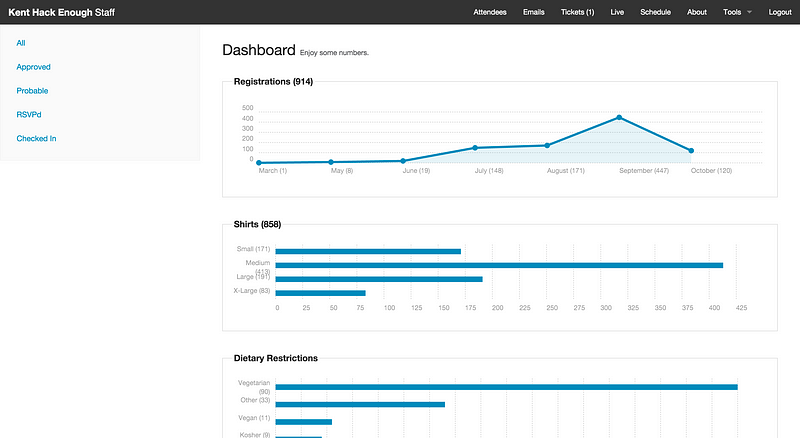
Attendee Management
As applications come in, we need a way to review them, accept/waitlist/deny people, and view specific information about them. This feature is basically just a searchable and filterable dump of all the registrations. I also built a little equation that estimated the number of attendees that will actually show up (which, as you can see, needs some adjustment).

Check In
During check-in on the first day of the event, we needed an easy way to quickly find hackers, verify their phone numbers, and mark their attendance. The check-in screen met that need really nicely. It also has a way to quickly register any walk-up attendees. Finally, it all updates with web sockets (as does the rest of the API), so our volunteers working the check-in tables never had to refresh the page to see each others’ changes or to get a live count of numbers.
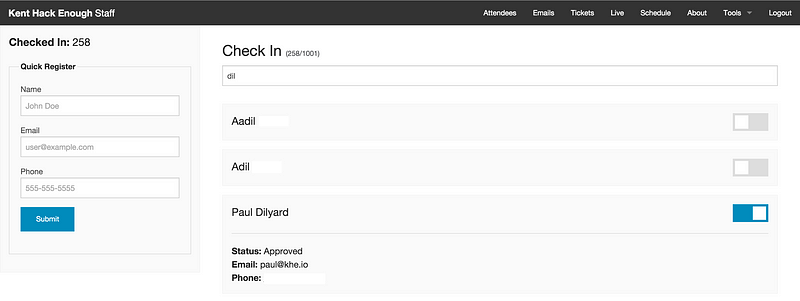
Tickets
Ticketing systems can get really complicated, so I just kept mine simple and without too many features. This has a lot of room for improvement, but it was better than having an inbox full of emails.

Live Updates
We wanted to be able to send out push notifications during the event to mobile devices and web browsers. A simple messaging system did the trick.
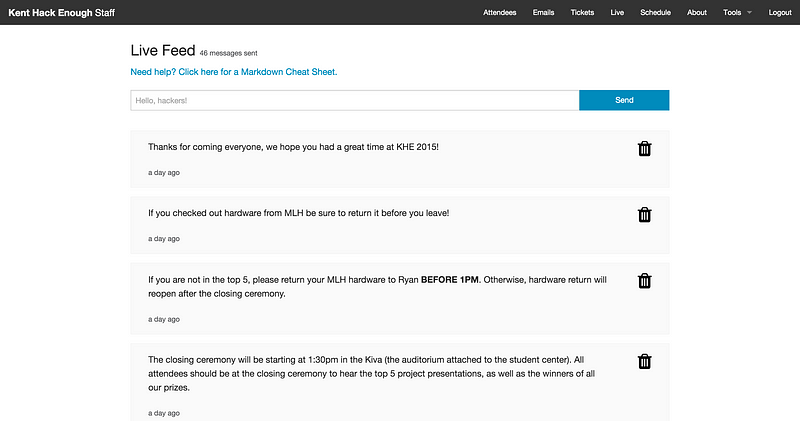
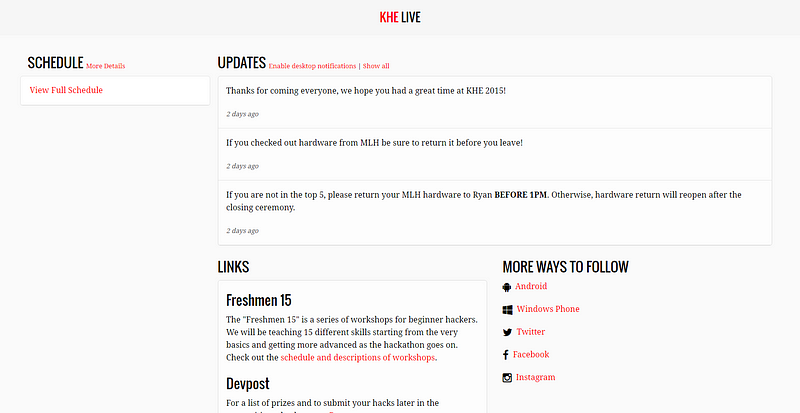
Schedule
This feature allowed us to easily update the schedule without changing HTML on the main website. This part of the site could also use some cleanup.
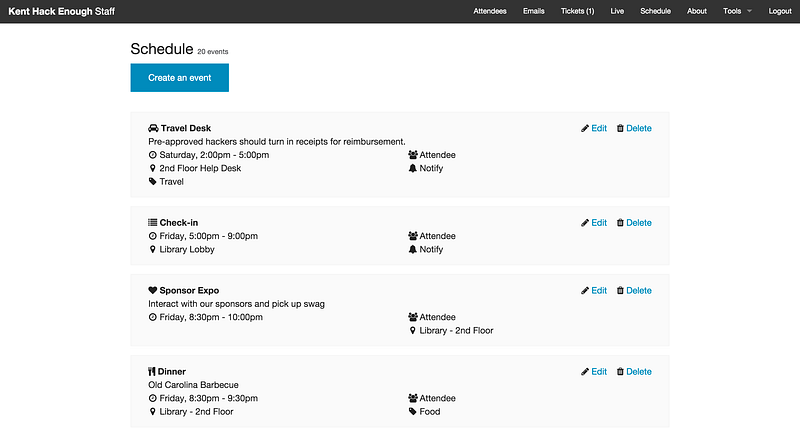

Mass emails
We’re using the SendGrid API to push out emails to certain attendees based on given parameters. The KHE API builds Markdown, saves the email to our database for the records, and then pushes it to SendGrid.
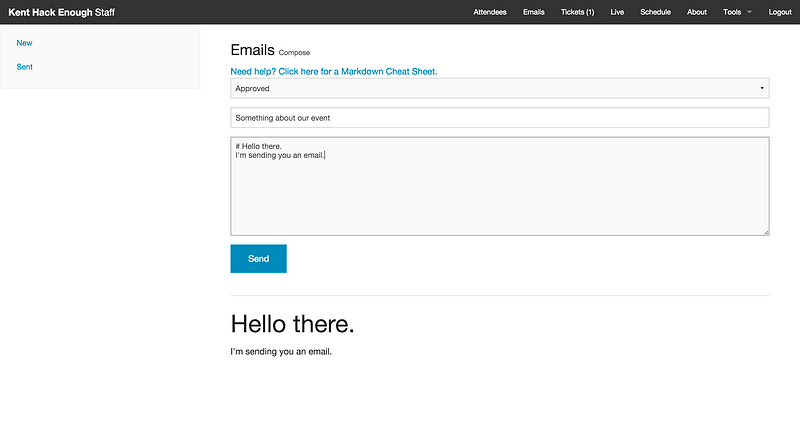
The last couple of features are pretty simple, so I won’t include screenshots. The URL shortener allows us to use pretty and branded URLs for links to things like the sponsorship packet, table assignment Google Doc, and more. It resolves URLs at http://go.khe.io/[MY_SHORT_URL]. Lastly, there are tools for downloading a CSV of every single application (useful for sharing with other people and for our on-site security), and for downloading a zip file of all the resumes that got uploaded.
Overall, I’m really happy with how the custom-built tools worked for us. I have a lot of ideas for improvement, and I would love to see what the community could come up with too. All the code is open-source and available here:
API (docs in wiki): https://github.com/hacksu/kenthackenough
Public front-end: https://github.com/hacksu/kenthackenough-ui-main
Staff front-end: https://github.com/hacksu/kenthackenough-ui-staff
Android app: https://github.com/hacksu/kenthackenough-android
I’m happy to share the code for these projects and I hope other hackathons find use in them. If you do decide to use the code, I have three favors to ask of you:
- Please give some sort of credit or shout-out to Kent Hack Enough. We love our hackathon and put a lot of work into it, so just respect that.
- Please contribute back to the main project (Fork and Pull Request, make issues, etc.). There is a lot of room for improvement, so we’d love to see other hackathons getting involved.
- Please do not just steal the code and use it as your own. This project is open so the community can benefit, but the community doesn’t benefit if you take without giving back. (I don’t envision this as much of a problem in the hackathon world, but I put this here just to be safe).
Google Drive
We still use Google Drive a lot — it’s great for financials, simple docs, file sharing, and lots more. We gave each of our teams a folder to dump files, and we kept track of our financial data here (budget, invoices, etc.). It was never our intention to leave or replace Drive (that’s pointless), as there really isn’t anything better for sharing documents.
Devpost
We used Devpost for submitting hacks. I originally planned to roll our own solution for project submission (we had a really cool attendee voting system planned), but in the end, decided to go with Devpost simply because it’s such a widely used platform.
We figured Devpost would be reliable day-of, but as it turns out, we had the same problem a lot of hackathons have been having this year: we never saw a pretty good percentage of the hacks. As submissions started rolling in, we started pushing out table assignments for the expo. Almost immediately, several teams started coming up to us asking why they hadn’t been given a table number. They showed us that their project had indeed been submitted to the correct hackathon on Devpost — we definitely should have been able to see their hack listed, but we couldn’t. We did what we could to improvise on the spot, and we feel like we recovered the best we could. Our first place winner was actually was one of these affected teams. We are still heart broken however, that some teams felt like we had failed to give them a spot to show off what they built. One first-time team thought their project wasn’t good enough to be shown at the expo, and that is absolutely not the impression we wanted to give off. We think every hacker’s project is wonderful and everyone deserves the chance to show what they’ve built and learned.
After the hackathon, we reached out to Devpost asking about the problem. We were basically told that the problem came down to user error, and that they knew they needed to improve their user experience. However, we knowfor a fact that hackers had correctly submitted their projects to us (they showed us directly on their laptops), so the problem is definitely more than skin deep.
UPDATE: We’ve since spoken with Devpost employees to give further information and they’ve rolled out new features that should help with the UX problem of not submitting your project to a hackathon. Hopefully this helps.
Major League Hacking
MLH isn’t exactly a “tool”, but we had a similar experience with MLH as we did with Devpost. This season, we were one of the first hackathons to apply to be sanctioned. We quickly completed their required checklist, and we thought we were all set. Then, when the first version of the Fall Schedule came out, we were missing. We didn’t appear on the schedule for another two weeks. We even were the first hackathon to put the MLH banner on our website, which not a single hackathon on the schedule had done at the time. They did not enforce this rule with the larger hackathons, like PennApps or MHacks.
Not only this, but we started to get really frustrated with the set up of their calls. MLH has monthly calls with the organizers where they make sure you have your homework done. Seriously. They read a checklist of items and ask if you’ve completed them. Collegiate hackathons are built for students, by students, we don’t need to report to an outside company. We love our hackathon, and we have experience planning it; we don’t need to be babysat (we already had everything on their list completed anyway). At the very end of each monthly call, our MLH rep would then ask if there was anything MLH could do to help. The only thing we ever asked for was help with our social media — we were creating cool content and we wanted more of the hacker community to see it. MLH never retweeted anything unique about our event, like the FooBar or the Freshmen 15. They only ever tweeted out a standard, boring register here kind of tweet. They didn’t take the time to understand what our event was about and help us spread the word.
On top of this, MLH scheduled Local Hack Day for the same weekend of Kent Hack Enough. It was not a huge deal, as we understand that there will have to be a conflict with something no matter what weekend they choose, and we were able to convince most of the local schools to come to Kent Hack Enough instead of hosting a LHD at their school. It did, however become an issue the day of the event. The same weekend, Swift went to HackNC, Nick Quinlin went to CalHacks, yet we were sent an MLH employee’s sibling… This person was great, we have no complaints about him. However, getting a non-employee did not make us feel like a priority to MLH. As a non-employee, he did not have access to some of the software for the hardware lab, and there was some weirdness there. He also didn’t have access to the Twitter account, so while we were having a great time in Kent, the hacker community largely did not know because MLH was too busy tweeting about HackNC, CalHacks, and Local Hack Day. Over the course of the weekend, MLH tweeted 15 times about HackNC or CalHacks, and only once about Kent Hack Enough.
After the event, we spent a lot of time compiling feedback for MLH in their post-event survey. We had a scheduled call with our MLH rep the next day, and after we listened to a terrible Mario meets Taylor Swift version of “Shake It Off” loop 3 times while on hold, no one ever joined the conference line. Our MLH rep also forgot about another one of our monthly calls earlier this summer.
We love Major League Hacking’s dedication to the hacker community, but we were disappointed when we got the feeling that MLH only cares about the big hackathon. We feel that MLH’s hand is reaching too far into the business of planning hackathons — they should be there to help us, not rule over us.
MLH isn’t helping anyone by sanctioning hundreds of events. If they can’t provide the same quality of support to every hackathon, they should stop sanctioning so many.
UPDATE: Even though we posted this story in HH well after midnight, Jon Gottfried and Mike Swift immediately got on a phone call with us to discuss. They clarified that our on-site MLH rep was, in fact, an employee of MLH, as well as a few other issues. They also let us know that they would love to hear this kind of feedback earlier in the process. Jon and Swift ensured us that they ❤ the small hackathon.
Marketing
Obviously, Kent Hack Enough is a small hackathon in Northeast Ohio. Kent isn’t known for our CS Department, and we don’t even have a full engineering school. To reach our growth goals this year, we knew we’d have to go outside of Kent State University with our marketing.
One of our volunteers went completely above and beyond and did a ton of research in our area. He sent out over 400 unique emails to different university faculty, student organizations, and students. He also began reaching out to our regional campuses at Kent State, which is something we’d never done before. This volunteer was also the student that, early-on in the semester, plastered our posters all over the university, in every single building.
Social Media
We also strived to really improve our social media this year. We figured our Twitter and Facebook pages would be key tools to recruit students from other schools. We tried to improve this by creating more interesting content. This started with videos. We had a volunteer animate a handful of trailers that featured cool card motions. He also made a hilarious Shia Laboeuf video when that first came out. (See below — Plus the rest of our channel can be seen here.)
We also tried to create more interesting graphics for other posts promoting different initiatives like our foobar and the Freshmen 15. Some of these posts can be seen below.
Overall, our social media was really successful. We were able to raise our number of views on an average Facebook post from about 200 views or less to an average of 2,000 views, with most posts being between 1,000 to 6,000 views. We did this by obnoxiously sharing our posts to groups like HH Design, Hackathon Hackers, and Ladies Storm Hackathons. We also shared our posts around Kent State Facebook groups, and had our volunteers periodically like and comment on the posts to keep them relevant in these groups.
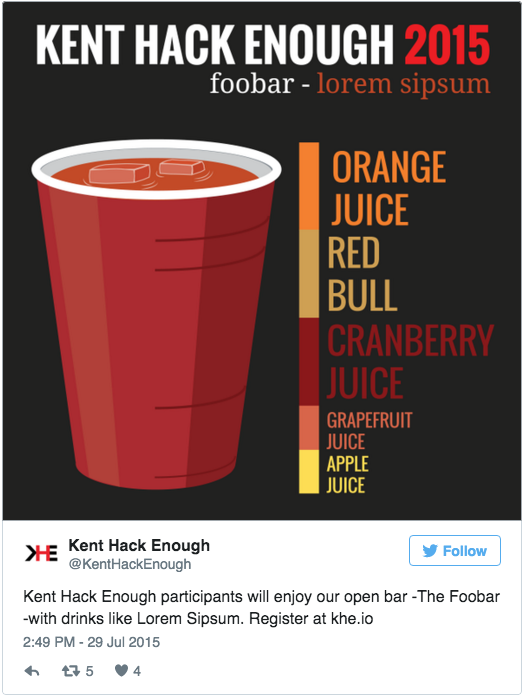 The foobar
The foobar
By far, our most successful post was when we announced the foobar. It may sound surprising, but this started as a health initiative after hearing horror stories of hackathons having to send attendees to the ER because of the unhealthy food and massive quantities of energy drinks. We wanted to create a way for people to enjoy energy drinks in a healthier, more controlled way. We thought about having a smoothie bar and forcing people to ingest fruits with the energy drinks, and eventually this turned into the foobar, where we took classic alcoholic drinks and replaced the alcohol with similar fruit juices and Red Bull.
People loved the wittiness of the name, and the names of the drinks and it sparked a lot of engagement because it was fairly controversial. Many people did not believe we would follow through, as some other hackathons have done in the past. People also did not understand initially that the drinks were nonalcoholic. This post reached over 6,000 people on Facebook and had 110 Likes, Comments, and Shares, as well at 981 Post Clicks. Interestingly, we also had an almost 5% spike in female registration after this post, but not when we announced our partnership with The Fashion School.
Attendee Statistics
We tried to collect as much information about our attendees as possible without making our application form too grueling. Overall, we’re pretty happy with our numbers, as we met our goal of 250 attendees.
The basic numbers
Total number of registrations: 864
Total number of RSVPs: 341
Total number of attendees: 258
Attendees/registrations: 29.8% (or a 70.2% churn rate)
Of those 258 attendees, 62 of them (24.0%) were walk-ins (meaning they had not registered on the website prior to the event). We only got about 30% of sign-ups to come to the event, which can probably be attributed to our budget for travel reimbursement and busses.
Gender distribution
Male: 82.6%
Female: 15.8%
Other: 1.4%
These numbers obviously aren’t the best, but we don’t feel they represent our efforts in this area. The entire idea behind our party branding is to make the event more approachable to all. We had the Freshmen 15 to encourage more diverse populations of students to try out a hackathon. We also partnered with The Fashion School and The School of Journalism and Mass Communication, which have two of the most diverse populations on campus. We had more females than ever help plan the event. We don’t have the statistics from last year, but this is definitely a priority for improvement in the future.
Hacker experience levels
108 (41.9%) of our attendees were first-time hackers. This is a number that we are extremely proud of. We strive to be a really welcoming environment for beginners, and we think this number directly reflects that effort.
108 (41.9%) of our attendees were Computer Science majors. We are really excited about the academic diversity of students we had at the event. KSU is does not have a large CS department, so we have to look elsewhere for a lot of attendees. These come from programs like Fashion, Architecture, Visual Communication Design, and more. We even had a Spanish major.
Lastly, here’s a breakdown of academic standing:
High School: 1.9%
Freshman: 10.1%
Sophomore: 15.9%
Junior: 20.5%
Senior: 22.5%
Grad Student: 7.4%
School representation
Our top three schools in attendance were Kent State University (34.5%),Ohio State University (5.8%), and Youngstown State University (7.0%). It is important to note that we only collected emergency contact information from walk-in attendees, so we don’t know a lot of detailed statistics about them. However, it is safe to guess that well over half of the walk-ins were from Kent State, so the 34.5% number is probably a lot higher in reality.
Areas for improvement
While we do believe that KHE was a huge success this year, we also know that there is always lots of room for improvement.
Project Expo
One thing we really wanted to improve is the project expo. So far, the science fair style is the best thing the hackathon community has to offer, but we feel that it still relies on a lot of luck and presentation ability. We try to pick judges that can see past the presentation and judge the hack for what it is, but it can be difficult sometimes. Unfortunately, we weren’t able to come up with a better idea than a science fair. We did have plans for a way that attendees could judge each other with an app (we had a whole algorithm written), but we ditched the idea because it started to become logistically impossible. We’re still looking for ideas in this area.
Diversity
While we’re really proud of the number of first time hackers and the diversity of majors, we know that we have a responsibility to improve in other areas (as mentioned above) and we plan to continue our efforts towards this challenge.
Conclusion
We’re incredibly proud of what we’ve been able to do with Kent Hack Enough in the course of two years. In this time we’ve raised attendance from 75 people to over 250. We believe we’re making a difference in the tech scene in our region of Northeast Ohio, and we can’t wait to see how Kent Hack Enough continues to grow in the future.

